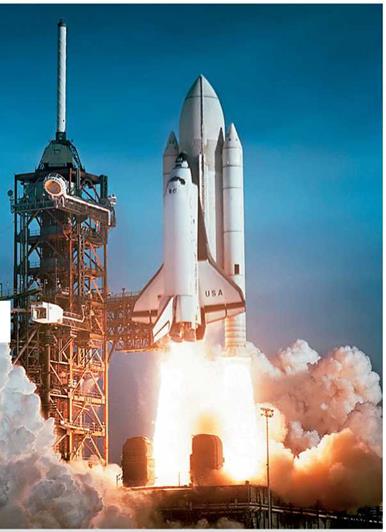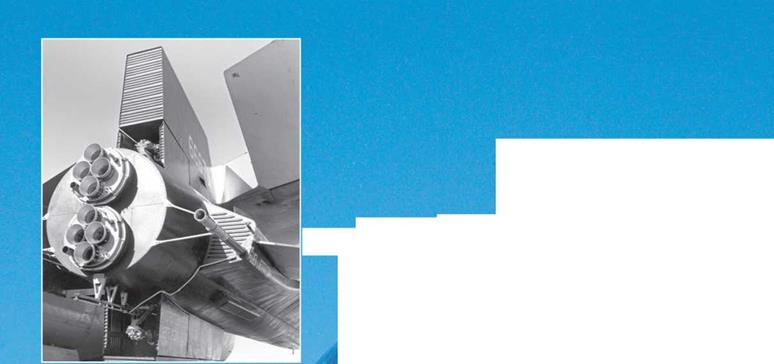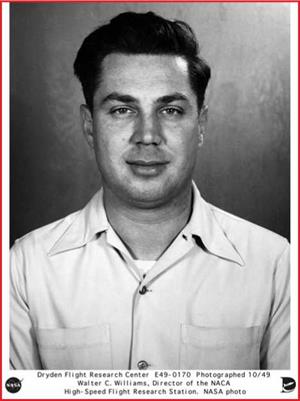AVIATION
North American Aviation’s dedicated group of engineers, set up by Vice President Ray Rice and supported later by Vice President Harrison Storms under the direction and leadership of Charlie Feltz, was tasked with designing the X-15.
North American Aviation was founded in 1928 by Clement Keys, a financier noted for aviation companies. In 1934, James H. “Dutch” Kindelberger became president, and he guided the organization through some of its most iconic highspeed airplane designs, such as the P-51 Mustang of World War II and America’s first swept-wing jet fighter, the F-86 Sabre.
 In addition to the X-15, North American designed the Apollo Command and Service Module and the Space Shuttle. Through a series of sales and mergers, NAA became part of the Boeing Airplane Company in 1996.
In addition to the X-15, North American designed the Apollo Command and Service Module and the Space Shuttle. Through a series of sales and mergers, NAA became part of the Boeing Airplane Company in 1996.


single civilian test pilot, Scott Crossfield of the NAA, achieved all the objectives of the program.
Indeed, the X-15 program was as much about the people involved as it was about the data the airplane was designed to collect, or even the airplane itself. The twelve distinguished test pilots who flew this extraordinary aircraft worked hard to learn its characteristics and idiosyncrasies as well as the unknown character of the new flight regime they were investigating. Truly accomplished aviators and apt students of each mission, they bravely addressed each flight with knowledge gained from long hours at flight simulators and with a detailed flight plan. As with any new airplane, difficulties arose. Equipment problems, design unknowns, and other circumstances caused
problems on many flights, although the X-15 flight-testing program claimed only one life in its nine-year history.
The NASA (NACA) flight research crew at Edwards AFB, now known as Dryden Flight Research Center, was a unique and motivated group that built upon their experience with the X-1 airplanes. The first director of the flight research crew for the X-15 was Walt Williams, who was director of the NACA High Speed Research Section, later to become the NASA Flight Research Center. He was also in charge of the early X-1 research flight tests at Pinecastle, Florida. He and his successor, Paul Bickle, ran a rigorous professional organization that continued research begun in the 1920s, when engineers at Langley Memorial Lab wanted to determine the most desirable characteristics for an airplane, as well as innovations in aircraft design that could make flying better, more effective, and safer.
These questions included what data to measure, how to fly to obtain it, how to measure and record it, and, finally, the commitment to publishing this data for the betterment of the industry.
As an example of this research trajectory, the X-15, with Pete Knight at the controls, reached a Mach number of 6.76 on October 3, 1967. On August 22, 1963, the X-15 had gained an altitude of 354,200 feet, more than 67 miles high, with Joe Walker piloting. These incredible achievements were made possible by the use of a supplementary automatic stabilization system, which the successful X-15 test flights proved was necessary in much of the new flight region. Moreover, the X-15 tests also showed that the thermal protection provided by special materials yielded desired favorable results.
The X-15 featured unique design features, including a rolling tail. Each side of the horizontal tail operated separately in opposite directions to roll the aircraft, eliminating the need for ailerons
|
Walter C. Williams. NASA |
on the wings; ailerons would have induced shock waves at supersonic speeds that would have changed the airflow at the tail surfaces. These shock waves, produced at the deflection hinge lines, would have caused local regions of high aerodynamic heating at that location.
To provide longitudinal control, the two sides of the horizontal tail would operate together in the same direction. The airfoil of the vertical tail surfaces was slab-sided, with a blunt trailing edge; this configuration prevented separated flow on the surface and maintained control at supersonic speeds. The new materials included Inconel X, which maintains its strength at high Mach numbers. Also, the structure was designed

to minimize the effects of thermal gradients when the outside aircraft skin got hot and the inside stayed cool. The X-15 proved that each of these innovations was successful.
The X-15 was the third and last of a series of air-dropped rocket-powered aircraft designed to investigate high-speed flight regimes from transonic through supersonic to hypersonic velocities. At the time each airplane was conceived and built, there were inadequate wind tunnel or other test data available to assist in the design for flight at these speeds; or in the case of the X-15, the wind tunnel tests had yet to be validated by flight. The X-1, D-558-2, X-2, and X-15 were the first aircraft to fly at Mach 1, 2, 3.2, and 6.7, respectively.
The X-15 had to fly through all the flight regimes that had been pioneered by the earlier research aircraft before extending its speed and altitude range to include the hypersonic regime. These older research aircraft were essentially conventional configurations, with special design
variations required for their specific mission.
Like its predecessors, the X-15 had to be dropped successfully from a mother ship, which for the X-15 was the B-52. After drop, the X-15 had to accelerate from subsonic speed through Mach 1 with its attendant shock waves, flow changes, and trim changes. It then climbed and accelerated past the maximum speed of the X-2 to explore the hypersonic regime for which it was designed.
The X-15’s rocket engine was a new, much larger version of the RMI rocket engine that powered the X-1 and the X-1A. The new engine needed to increase its thrust from the 6,000 pounds used by the X-1 to the 57,000 pounds required by the X-15’s greater Mach number research goals. The new, larger engine was not ready for the early flights, which instead used two of the 6,000-pound engines, combined for 12,000 pounds of thrust. These placeholder engines allowed early flights to proceed, providing data and experience useful for the continuation of the
X-15; XLR-11 dual rockets. USAF, Air Force Flight Test Center History Office, Edwards Air Force Base
![]()
![]()

program. The full rocket thrust duration was limited by the quantity of fuel carried and lasted approximately 90 seconds. Since the total time of flight on most missions was about 10 minutes, measured from drop from the B-52 to touchdown on the lakebed at EAFB, this meant that the X-15 flew for about 8У2 minutes without any engine power. As in all the rocket research aircraft, the
fuel was exhausted in the accelerating portion of the flights so that deceleration, descent, approach, and landing were all performed without power. While the larger X-15 was modified to carry more fuel, this expanded capacity merely extended the plane’s speed further into the hypersonic range; it did not provide power for landing.
The X-15 program left an important legacy in the development of manned hypersonic flight. It was, and still is, the fastest, highest-flying piloted airplane in history, and there is no new airplane design being planned in the foreseeable future that could do better. The X-15 met all of its design goals, and the results from its research flights allowed the following, among many others:
1) A verification of existing hypersonic aerodynamic theory and hypersonic wind tunnel techniques
2) A study of aircraft structures under the influence of severe, sustained aerodynamic heating
3) An investigation of stability and control problems associated with acceleration to high altitude, and atmospheric entry at hypersonic speeds
4) A study of the biomedical effects of both weightless and high-acceleration flight
The X-15 was an important steppingstone in the development of the Space Shuttle, which was more space vehicle than airplane but which had to experience hypersonic flight through the atmosphere every time it came back to earth.
The spectacular success of the X-15 program is a testimonial to the vision and courage of the engineers and managers who initiated the idea in the first place, the designers who created the vehicle, and the pilots who flew the airplane in the face of many unknowns. It is one of the most important stories in the annals of aviation history in general and aeronautical engineering in particular.
|
|
|
|
|
|
|














